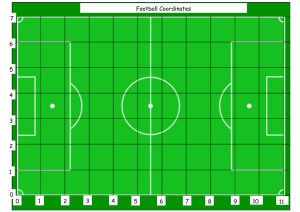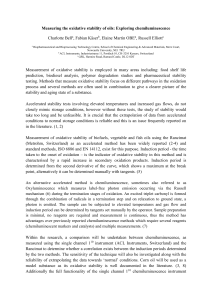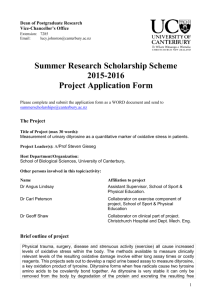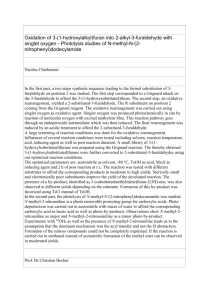(Soccer) Players in Intermittent High Intensity Exercise Protocol
advertisement
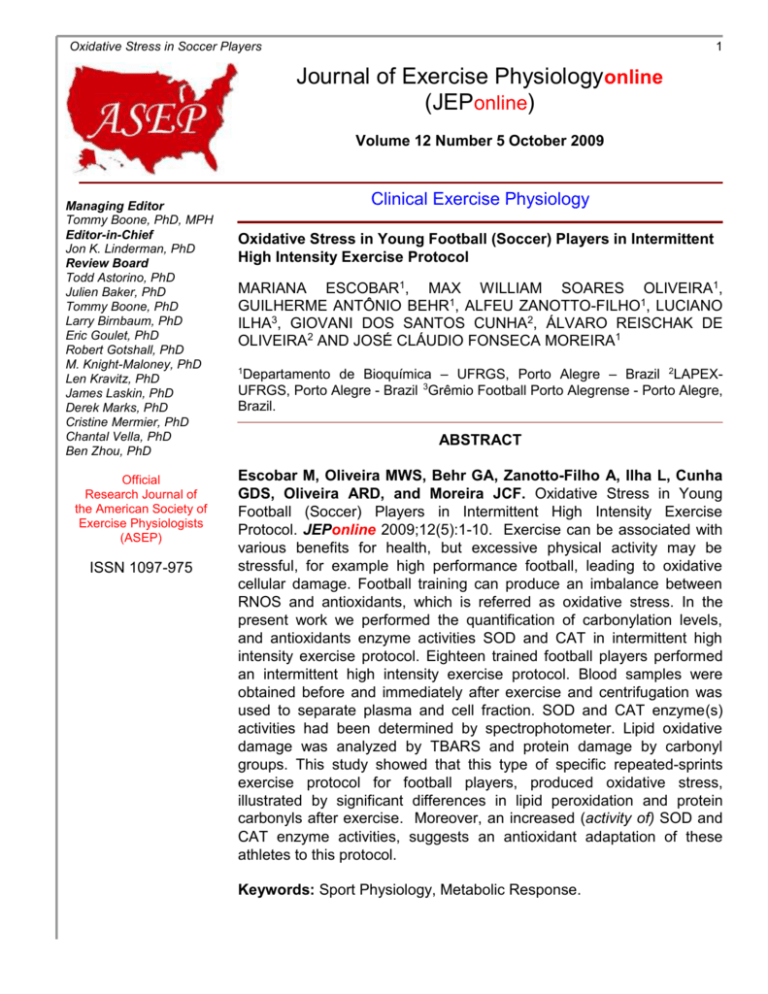
Oxidative Stress in Soccer Players 1 Journal of Exercise Physiologyonline (JEPonline) Volume 12 Number 5 October 2009 Managing Editor Tommy Boone, PhD, MPH Editor-in-Chief Jon K. Linderman, PhD Review Board Todd Astorino, PhD Julien Baker, PhD Tommy Boone, PhD Larry Birnbaum, PhD Eric Goulet, PhD Robert Gotshall, PhD M. Knight-Maloney, PhD Len Kravitz, PhD James Laskin, PhD Derek Marks, PhD Cristine Mermier, PhD Chantal Vella, PhD Ben Zhou, PhD Official Research Journal of the American Society of Exercise Physiologists (ASEP) ISSN 1097-975 Clinical Exercise Physiology Oxidative Stress in Young Football (Soccer) Players in Intermittent High Intensity Exercise Protocol MARIANA ESCOBAR1, MAX WILLIAM SOARES OLIVEIRA1, GUILHERME ANTÔNIO BEHR1, ALFEU ZANOTTO-FILHO1, LUCIANO ILHA3, GIOVANI DOS SANTOS CUNHA2, ÁLVARO REISCHAK DE OLIVEIRA2 AND JOSÉ CLÁUDIO FONSECA MOREIRA1 Departamento de Bioquímica – UFRGS, Porto Alegre – Brazil 2LAPEXUFRGS, Porto Alegre - Brazil 3Grêmio Football Porto Alegrense - Porto Alegre, Brazil. 1 ABSTRACT Escobar M, Oliveira MWS, Behr GA, Zanotto-Filho A, Ilha L, Cunha GDS, Oliveira ARD, and Moreira JCF. Oxidative Stress in Young Football (Soccer) Players in Intermittent High Intensity Exercise Protocol. JEPonline 2009;12(5):1-10. Exercise can be associated with various benefits for health, but excessive physical activity may be stressful, for example high performance football, leading to oxidative cellular damage. Football training can produce an imbalance between RNOS and antioxidants, which is referred as oxidative stress. In the present work we performed the quantification of carbonylation levels, and antioxidants enzyme activities SOD and CAT in intermittent high intensity exercise protocol. Eighteen trained football players performed an intermittent high intensity exercise protocol. Blood samples were obtained before and immediately after exercise and centrifugation was used to separate plasma and cell fraction. SOD and CAT enzyme(s) activities had been determined by spectrophotometer. Lipid oxidative damage was analyzed by TBARS and protein damage by carbonyl groups. This study showed that this type of specific repeated-sprints exercise protocol for football players, produced oxidative stress, illustrated by significant differences in lipid peroxidation and protein carbonyls after exercise. Moreover, an increased (activity of) SOD and CAT enzyme activities, suggests an antioxidant adaptation of these athletes to this protocol. Keywords: Sport Physiology, Metabolic Response. Oxidative Stress in Soccer Players 2 INTRODUCTION Football is a complex sport widely played, in which players need technical, tactical, and physical skills to succeed (1). This modality is characterized as an intermittent exercise, predominantly aerobic, with periods of high-intensity bursts. The observation that players perform 150-250 high intensity actions during a game and have blood lactate values of 2-14 mM indicates that the rate of anaerobic energy turnover is high during a match (2,3). Recent game analysis (4) has shown that some sprints are separated by short rest periods (<30s), which negatively affects the subsequent sprint performance (5). For that reason, long sprint training can improve repeated-sprint performance (6). However, only few studies have been undertaken using sprint protocols in humans. In football physical preparation, long sprint running (>10s) is used to train either the resistance to lactic acidosis or the ability to carry out long sprints in a high-speed, which are required in a counter-attack, for example. Long sprints are not usually seen in official football games, but play an essential role in the athletes’ physical preparation, being a widespread practice in Brazilian teams. The generation of reactive oxygen and nitrogen species (RNOS) occurs regularly as part of normal cellular metabolism, and is increased under conditions of physical stress (7). Therefore, football training can produce an imbalance between RNOS and antioxidants, which is known as oxidative stress. Physical activity increases oxygen consumption and generation of free radicals in several ways, indeed from 2% to 5% of oxygen used in the mitochondria originates free radicals in aerobic exercises (8). In sprint training, which is a predominantly anaerobic exercise, another source of RNOS may be mediated through various other pathways: namely xanthine and NADPH oxidase production, prostanoid metabolism, ischemia/reperfusion, phagocyte respiratory burst activity, disruption of iron-containing proteins, and alteration of calcium homeostasis (8,9). Other processes involved in RNOS production during exercise are increased central temperature, catecholamine and lactic acid, which have the ability to convert superoxide to hydroxyl (10,11). Exercise can be associated to various benefits for health, but excessive physical activity may be stressful, for example high performance football, leading to oxidative cellular damage (12,13). Cellular damage is often characterized by modifications in various macromolecules, including proteins, lipids, and nucleic acids, and can occur as a response to high-intensity exercise such as football, which requires high aerobic and anaerobic demands during a game (14-16). RNOS are neutralized in the body by an elaborate antioxidant defense system consisting of enzymes such as catalase (CAT), superoxide dismutase (SOD), glutathione peroxidase (GPx), and numerous non-enzymatic antioxidants, including vitamins E and C, glutathione, ubiquinone, and flavonoids (8,17). Regular exercise training is well-known as a potential factor of SOD, CAT and GPX increase, as shown by numerous studies, providing additional "protection" during periods of intense physical stress, which seems to be true for both aerobic and anaerobic exercise (18-21). Therefore, due to a lack of information regarding the redox effects of physical exercise in football players, we measured lipid peroxidation, carbonylation levels, and antioxidants enzyme activities SOD and CAT in an intermittent high intensity exercise protocol. METHODS Subjects Eighteen trained young football players from Grêmio Football Porto Alegrense (Brazil) volunteered this study. Mean age, height, body mass, and percentage body fat were respectively: 17 ± 0.5 years, 174 ± 5 cm, 74.0 ± 6.5 kg and 9.7 ± 1.6%. Body fat percentage was estimated from skin folds sum, according to Jackson and Pollock (22). All players signed the written informed consent. This study Oxidative Stress in Soccer Players 3 was approved by the Research Ethics Committee of Universidade Federal do Rio Grande do Sul (UFRGS). No subject reported antioxidant compound intake, including vitamins and/or medications. The athletes were instructed to avoid drinking alcoholic beverages or caffeine for at least 24 hours before the exercise testing day. The athletes received a 500 ml sport drink 2 hours before the game, to ensure the euhydration state. The athletes did not consume any fluid during the exercise. Experimental Procedures The tests were performed in the grass training field of Grêmio Football Porto Alegrense Stadium. The temperature and relative humidity were 4 degrees Celsius and 54%, respectively. This is considered a cool temperature in Brazil that does not cause any additional heat stress. The blood samples were collected during a typical training session, which consisted of 15 minutes of warm up followed by 10 sets of 200 meters sprints repeated twice (10 x 2 x 200 m), which means 20 sprints of 200 meters. There was a 30 seconds recovery between each 200 meters sprint and a 90 seconds recovery after two consecutive sprints. The athletes performed 200 meters in 40 seconds with an average speed of 18 km.h-1. This kind of exercise is classified as a long duration (>10s), repeated-sprint training (23). Blood samples (10 ml) were obtained from antecubital vein before and immediately after exercise. Centrifugation was used to separate plasma and cell fraction. Dehydration and Osmolality Body mass was measured using a digital balance (Plena, model MS-601) before and after the training. The relatively small changes in mass due to substrate oxidation and other sources of water loss were ignored. Players were instructed to adjust physiological needs (e.g., urination) prior to the measurement of body mass. The perceptual of dehydration was calculated by the differences between the initial and final body mass measurements. Plasma osmolality (mOsm/kg) was measured by a Vapro® Vapor Pressure Osmometer (Wescor). Blood Lactate and Glucose Lactate and glucose concentration were obtained from a finger blood sample and immediately measured by a Lactate analyzer (AccuSport, Roche, Germany) and a glucose analyzer (Accu Check Active, Roche, Germany). Antioxidant Enzyme Activities The superoxide dismutase (SOD, E.C. 1.15.1.1) activity in plasma samples was measured spectrophotometrically by the inhibition rate of auto-catalytic adrenochrome formation in a reaction buffer containing 1 mM adrenaline/50 mM glycine–NaOH (pH10.2)/1 mMcatalase, as previously described (Klamt et al., 2002). Catalase (CAT, E.C. 1.11.1.6) activity was assayed by measuring the hydrogen peroxide (H2O2) decreasing rate (24). Erythrocytes samples (300µL) were centrifuged (3000 ×g; 10 min) and 100 µL of supernatant was mixed with 1 mL of phosphate buffer with 14 mM H2O2 (40 µL). Absorbance was followed for 60 s at 240 nm. Proteins Carbonyl Content As an index of protein oxidative damage, the carbonyl groups were determined (25). Proteins from 300 µl of plasma were precipitated by the incubation with thiobarbituric acid (TCA) 20% (100 µl) for 5 minutes on ice, and then centrifuged at 4000 ×g for 5 minutes. The pellet was dissolved in 100 µl of NaOH 0.2 M, and 100 µl of HCl 2 M or 10 mM of 2,4-dinitrophenylhydrazine (DNPH) in HCl 2 M was added to duplicate aliquots for blanks or for carbonyl groups derivatizing, respectively. Samples were maintained for 30 minutes at room temperature. Proteins were precipitated with TCA, and washed three times with 500 µl 1:1 ethanol: ethyl acetate with 15 minutes standing periods to remove excess of DNPH. Samples were dissolved in 200 µl 6 M guanidine in 20mM KH 2PO4, pH 2.3. Absorbance Oxidative Stress in Soccer Players 4 was read at 370 nm. Carbonyl content (nmol/mg protein) was calculated using a molar extinction coefficient of 22,000 M/cm at 370 nm after subtraction of the blank absorbance. Lipid Oxidative Damage Malondialdehyde (MDA) production, an index of lipid peroxidation, was assessed by the quantification of thiobarbituric acid-reactive species (TBARS) as previously described (26). Briefly, samples were mixed with 600 µL of TCA 10%, centrifuged (10,000 ×g; 10 min) and 500 µL of the supernatant mixed with 500 µL of thiobarbituric acid 0.67% (TBA). Then, the sample was heated in a boiling water bath for 15 minutes. TBARS were determined by absorbance at 532 nm. Statistical Analyses All data are expressed as means SEM. Data were analyzed using SPSS (Version 12.0) statistical software. Paired t-test was used to compare variables before and after exercise. Significance was indicated by p values ≤ 0.05. RESULTS Dehydration, Osmolality, Blood Glucose and Lactate Athletes dehydrated 1.8 ± 0.2% of their body mass at the end of the training. Plasma osmolality was 252.6 4.79 mOsmol/kg at rest and 272.8 4.4 mOsmol/kg after exercise. Data suggest that exercise did not alter dehydration. In addition, a significant increase in blood glucose and lactate levels was observed after exercise. Blood glucose at rest and after exercise was 82.7 2.7 mg/dl and 99.2 3.4 mg/dl, respectively (Figure 1A). Blood lactate at rest and after exercise was 1.6 0.1 mg/dl and 4.1 0.4 mg/dl, respectively (Figure 1B). Oxidative Stress Parameters Plasma SOD activity increased significantly revealing values of 9.10 0.71 U SOD/mg protein at rest and 12.0 0.8 U SOD/mg protein after exercise (Figure 1C). Catalase activity increased, from 51.9 ± 2.7 U CAT/mg protein at rest and 62.5 ± 2.7 U CAT/mg protein after exercise (Figure 1D). The relation between enzymes (SOD/CAT) did not change significantly (e.g., 0.18 ± 0.01 at rest and 0.20 ± 0.02 after exercise) (Figure 2A). Lipid peroxidation, which was measured by TBARS assay, increased significantly from 0.32 ± 0.02 nmol/mg protein at rest to 0.57 ± 0.06 nmol/mg protein after exercise (Figure 2B) Plasma protein carbonyl groups increased significantly after exercise, being 0.59 ± 0.05 nmol/mg protein at rest and 1.13 ± 0.06 nmol/mg protein after exercise (Figure 2C). DISCUSSION Dehydration Due to the lack of information in this area, we investigated the effects of high intensity exercise on redox state (i.e., the balance between the activities of non-enzymatic and enzymatic defense and production of ROS). We observed that the football players’ fluid loss was about 1.8% of their body weight. Numerous authors have shown that football players have considerable percentage of dehydration (27-29), reaching values of 1.2% after training sessions and 1.4% after competition (30). The American College of Sports Medicine (31) recommends that a percentage equal to or greater than 2% of the body mass characterizes dehydration, of which if followed by a plasma osmolality higher than 290 mOsmol/kg can induce performance failures. In our study, the negative effect of dehydration was not noticed. The fluid loss did not induce a poorer repeated-sprint performance. The athletes completed the entire experimental protocol without prejudice of the performance. However, the oxidative stress parameters demonstrated clear influences on the performance evaluated. Oxidative Stress in Soccer Players 5 Blood Lactate and Glucose Even though CHO consumption was not allowed during exercise, a significant increase was found in glucose concentration after the exercise. This finding can be explained by the players’ hormonal factors that may have had an influence on the glucose kinetics during the exercise. Other authors (32-34) have also found higher values of glucose after exercise when compared to the rest values, and as well they report increased levels of catecholamines. During Figure 1. A; Blood glucose, B; Lactate, C; Superoxide Dismutase exercise, blood glucose activity (SOD), and D; Erythrocyte catalase activity (CAT). Results levels are maintained by are expressed as mean ± SEM, *; p<0.05. the liver through hepatic glycogenolysis and gluconeogenesis. As a result, circulating glucose levels remained stable. This relatively simple and effective relationship between the liver and the skeletal muscle is maintained by a complex interplay of circulating and locally released neuroendocrine controllers (35). Moderate blood lactate concentrations found in the present study suggest that the rate of glycolysis is high for any period of time during the exercise. Gaitanos et al. (36) reported that there was no significant change in lactate during their protocol test. They suggested that a greater contribution from aerobic matebolism partly counteracted the reduction in anaerobic glycogenolysis. Thus, it appears that while the aerobic contribution to a single and short duration sprint is relatively small, there is an increased aerobic contribution to repeated sprints. The energy system contribution during repeated sprints appears to be heavily influenced by the duration of the sprints (23). After 20 repeated sprints performed in our protocol, we can explain the moderate lactate rates and high levels of glucose in the blood by the reduction of anaerobic glycogenolysis and the increase of aerobic metabolism. Antioxidant Enzyme Activies The significant increase in SOD activity can be explained by the increase in the superoxide radical during exercise (37). Superoxide radical is connected to the conversion of hemoglobin to metheinoglobin in the erythrocyte during exercise and is converted into H 2O2 by SOD (38). SOD functions in the cell as one of the primary enzymatic antioxidant defenses against superoxide radicals, taken together with increases in SOD enzyme activity, corresponds to an enhanced resistance to oxidative stress (39). Another study observed a similar relationship, with higher rest plasma SOD activity in football players compared to untrained subjects (40). Oxidative Stress in Soccer Players 6 We found significant differences in CAT activity, although there are few indicators suggesting that the exercise training provides increases in CAT activity in the skeletal muscle. Some studies have reported decreases or a leveling off in erythrocyte CAT activity immediately after the exercise protocol (41-43). As an antioxidant enzyme, CAT catalyses the breakdown of H2O2 to form water and O2. CAT is widely distributed in the cell with high concentrations in both peroxisomes and mitochondria. Also, this activity is greater in muscle fibers with high oxidative Figure 2. Oxidative stress parameters: A; SOD/CAT capacities and is lower in the Balance, B; Thiobarbituric acid reactive substances muscle fibers with low oxidative (TBARS) in plasma, C; Plasma levels of protein carbonyl capacities (44,45).The imbalance groups. Data were compared to resting levels. Results are between the antioxidant enzyme SOD and CAT can be followed by expressed as mean ± SEM, *; p<0.05. oxidative damage (23,46,47). In our study, SOD/CAT balance did not change, demonstrating a balance in the activity of these two antioxidants enzymes. Protein and Lipid Oxidative Damage In our study, plasma carbonylation levels were increased post-exercise when compared to the rest. Other authors (48,49) have also shown an increase in protein carbonyls immediately after exercise. Thus, the exercise of long duration or high intensity can increase significantly the concentration of carbonyl after exercise. Several factors (50) may trigger the production of RNOS and increase the ability for protein oxidation (e.g., invasion of phagocytic cells, hemolysis resulting in an increase in free iron and an imbalance in the calcium homeostasis). The increase in RNOS production from any of the these sources could lead to amino acid side chains oxidation and polypeptides fragmentation, as all amino acids are susceptible to metal-catalyzed oxidation (21). In agreement with other authors (51,52), an increased lipid peroxidation levels was found after the exercise. However, some studies (53,54) have shown contrasting results. This discrepancy may be due to the fact that each study had different variables, such as intensity, sample nature and type of exercise. The MDA rises seem to be more dependent on increased oxygen uptake levels than transient periods of ischemia and reperfusion, infiltration of phagocytic cells or calcium homeostasis imbalance. These aspects connected to muscle injury might be more related to protein carbonyls results (55) than the MDA results. Oxidative Stress in Soccer Players 7 CONCLUSIONS In summary, this study showed that this type of specific repeated-sprint exercise protocol produces oxidative stress in football players. The oxidative damage is demonstrated by the proteins carbonyls and lipid peroxidation raised levels. However, the significant increase in SOD and CAT enzymes activity suggests an antioxidant adaptation of these athletes to this protocol. Unlike the amateur athletes, the use of oxidative stress markers both in professional football and other sports that require a high performance may be used together with other markers as a tool to prevent injuries and overtraining. Currently, children have been practicing high performance sports earlier every generation. Those parameters are extremely relevant that training does not impair growth and the development of children. Thus, the “redox state” of the individual can be used as an additional marker in the physical training and the prevention of injuries. Address for correspondence: Mariana Escobar, MSc., Departamento de Bioquímica, ICBS Universidade Federal do Rio Grande do Sul, Rua Ramiro Barcelos 2600 - anexo. Porto Alegre, RS, Brazil, CEP 90035-003. Tel:55 51 33085578 e-mail: mariana@marianaescobar.com.br. REFERENCES 1. Helgerud, J., Engen, L. C., Wisloff, U.,Hoff, J. Aerobic endurance training improves soccer performance. Med Sci Sports Exerc 2001; 33:1925-1931. 2. Krustrup, P.; Bangsbo, J. Physiological demands of top-class soccer refereeing in relation to physical capacity: effect of intense intermittent exercise training. J Sports Sci 2001;19:881891. 3. Mohr, M.; Krustrup, P.; Bangsbo, J. Fatigue in soccer: A brief review. J Sports Sci 2005; 23:593-599. 4. Spencer, M.; Lawrence, S.; Rechichi, C.; Bishop, D.; Dawson, B.; Goodman, C. Time-motion analysis of elite field hockey, with special reference to repeated-sprint activity. J Sports Sci 2004; 22:843-850. 5. Balsom, P. D.; Seger, J. Y.; Sjodin, B.; Ekblom, B. Physiological-Responses to Maximal Intensity Intermittent Exercise. Eur J Appl Physiol Occup Physiol 1992; 65:144-149. 6. Edge, J.; Bishop, D.; Goodman, C.; Dawson, B. Effects of high- and moderate-intensity training on metabolism and repeated sprints. Med Sci Sports Exerc 2005; 37:1975-1982. 7. Bloomer, R. J.; Goldfarb, A. H.; Wideman, L.; McKenzie, M. J.; Consitt, L. A. Effects of acute aerobic and anaerobic exercise on blood markers of oxidative stress. J Strength Cond Res 2005;19:276-285. 8. Clarkson, P. M. Antioxidants and Physical Performance. Crit Rev Food Sci Nutr 1995; 35:131-141. 9. Fehrenbach, E.; Northoff, H. Free radicals, exercise, apoptosis, and heat shock proteins. Exerc Immunol Rev 2001;7:66-89. 10. Clarkson, P. M.; Thompson, H. S. Antioxidants: what role do they play in physical activity and health? Am J Clin Nutr 2000;72:637S-646S. Oxidative Stress in Soccer Players 8 11. Cooper, C. E.; Vollaard, N. B.; Choueiri, T.; Wilson, M. T. Exercise, free radicals and oxidative stress. Biochem Soc Trans 2002;30:280-285. 12. Mastaloudis, A.; Leonard, S. W.; Traber, M. G. Oxidative stress in athletes during extreme endurance exercise. Free Radic Biol Med 2001;31:911-922. 13. Sjodin, B.; Westing, Y. H.; Apple, F. S. Biochemical-Mechanisms for Oxygen Free-Radical Formation During Exercise. Sports Medicine 1990;10:236-254. 14. Bloomer, R. J.; Goldfarb, A. H. Anaerobic exercise and oxidative stress: A review. Can J Appl Physiol 2004;29:245-263. 15. Mastaloudis, A.; Leonard, S. W.; Traber, M. G. Oxidative stress in athletes during extreme endurance exercise. Free Radic Biol Med 2001; 31:911-922. 16. Krustrup, P.; Mohr, M.; Steensberg, A.; Bencke, J.; Kjaer, M.; Bangsbo, J. Muscle and blood metabolites during a soccer game: implications for sprint performance. Med Sci Sports Exerc 2006;38:1165-1174. 17. Urso, M. L.; Clarkson, P. M. Oxidative stress, exercise, and antioxidant supplementation. Toxicology 2003;189:41-54. 18. Clarkson, P. M. Antioxidants and physical performance. Crit Rev Food Sci Nutr 1995;35:131141. 19. Ji, L. L. Oxidative Stress During Exercise - Implication of Antioxidant Nutrients. Free Radic Biol Med 1995;18:1079-1086. 20. Leeuwenburgh, C.; Heinecke, J. W. Oxidative stress and antioxidants in exercise. Curr Med Chem 2001;8:829-838. 21. Radak, Z.; Taylor, A. W.; Ohno, H.; Goto, S. Adaptation to exercise-induced oxidative stress: From muscle to brain. Exerc Immunol Rev 2001;7:90-107. 22. Jackson, A. S.; Pollock, M. L. Generalized Equations for Predicting Body Density of Men. Br J Nutr 1978;40:497-504. 23. Spencer, M.; Bishop, D.; Dawson, B.; Goodman, C. Physiological and metabolic responses of repeated-sprint activities - Specific to field-based team sports. Sports Medicine 2005; 35:1025-1044. 24. Aebi, H. Catalase in vitro. In: Lester, P. eds. Methods Oxygen Radicals in Biological Systems. Academic Press; 1984:121-126. 25. Levine, R. L.; Garland, D.; Oliver, C. N.; Amici, A.; Climent, I.; Lenz, A. G.; Ahn, B. W.; Shaltiel, S.; Stadtman, E. R. Determination of Carbonyl Content in Oxidatively Modified Proteins. Methods Enzymol 1990; 186:464-478. 26. Esterbauer, H.; Cheeseman, K. H. Determination of Aldehydic Lipid-Peroxidation Products Malonaldehyde and 4-Hydroxynonenal. Methods Enzymol 1990; 186:407-421. in Enzymology Oxidative Stress in Soccer Players 9 27. Barr, S. I. Effects of dehydration on exercise performance. Can J Appl Physiol 1999;24:164172. 28. Maughan, R. J.; Merson, S. J.; Broad, N. P.; Shirreffs, S. M. Fluid and electrolyte intake and loss in elite soccer players during training. Int J Sport Nutr Exerc Metab 2004;14:333-346. 29. Maughan, R. J.; Shirreffs, S. M.; Merson, S. J.; Horswill, C. A. Fluid and electrolyte balance in elite male football (soccer) players training in a cool environment. J Sports Sci 2005; 23:7379. 30. Broad, E. M.; Burke, L. M.; Cox, G. R.; Heeley, P.; Riley, M. Body weight changes and voluntary fluid intakes during training and competition sessions in team sports. Int J Sport Nutr 1996; 6:307-320. 31. Sawka, M. N.; Burke, L. M.; Eichner, E. R.; Maughan, R. J.; Montain, S. J.; Stachenfeld, N. S. American College of Sports Medicine position stand. Exercise and fluid replacement. Med Sci Sports Exerc 2007;39:377-390. 32 . Gaitanos, G. C.; Williams, C.; Boobis, L. H.; Brooks, S. Human Muscle Metabolism During Intermittent Maximal Exercise. J Appl Physiol 1993; 75:712-719. 33. Krustrup, P.; Mohr, M.; Steensberg, A.; Bencke, J.; Kjaer, M.; Bangsbo, J. Muscle and blood metabolites during a soccer game: implications for sprint performance. Med Sci Sports Exerc 2006; 38:1165-1174. 34. Sawka, M. N.; Burke, L. M.; Eichner, E. R.; Maughan, R. J.; Montain, S. J.; Stachenfeld, N. S. American College of Sports Medicine position stand. Exercise and fluid replacement. Med Sci Sports Exerc 2007; 39:377-390. 35. Coker, R. H.; Kjaer, M. Glucoregulation during exercise - The role of the neuroendocrine system. Sports Med 2005; 35:575-583. 36. Gaitanos, G. C.; Williams, C.; Boobis, L.; Brooks, S. Human Muscle Metabolism During Intermittent Maximal Exercise of Brief Duration. J Physiol London 1993;467:76. 37. Ji, L. L.; Katz, A.; Fu, R. G.; Griffiths, M.; Spencer, M. Blood Glutathione Status During Exercise - Effect of Carbohydrate Supplementation. J Appl Physiol 1993;74:788-792. 38. Inal, M.; Akyuz, F.; Turgut, A.; Getsfrid, W. M. Effect of aerobic and anaerobic metabolism on free radical generation swimmers. Med Sci Sports Exerc 2001;33:564-567. 39. Powers, S. K.; Lennon, S. L. Analysis of cellular responses to free radicals: focus on exercise and skeletal muscle. Proc Nutr Soc 1999; 58:1025-1033. 40. Brites, F. D.; Evelson, P. A.; Christiansen, M. G.; Nicol, M. F.; Basilico, M. J.; Wikinski, R. W.; Llesuy, S. F. Soccer players under regular training show oxidative stress but an improved plasma antioxidant status. Clin Sci (Lond) 1999; 96:381-385. 41. Aguilo, A.; Tauler, P.; Gimeno, I.; Fuentespina, E.; Pons, A. Changes in erythrocyte antioxidant enzymes during prolonged submaximal exercise. Biofactors 2000;11:27-30. Oxidative Stress in Soccer Players 10 42. Lekhi, C.; Gupta, P. H.; Singh, B. Influence of exercise on oxidant stress products in elite Indian cyclists. Br J Sports Med 2007;41:691-693. 43. Tauler, P.; Aguilo, A.; Guix, P.; Jimenez, F.; Villa, G.; Tur, J. A.; Cordova, A.; Pons, A. Preexercise antioxidant enzyme activities determine the antioxidant enzyme erythrocyte response to exercise. J Sports Sci 2005;23:5-13. 44. Powers, S. K.; Lennon, S. L. Analysis of cellular responses to free radicals: focus on exercise and skeletal muscle. Proc Nutr Soc 1999;58:1025-1033. 45. Aguilo, A.; Tauler, P.; Fuentespina, E.; Tur, J. A.; Cordova, A.; Pons, A. Antioxidant response to oxidative stress induced by exhaustive exercise. Physiol Behav 2005; 84:1-7. 46. Andrades, M.; Ritter, C.; Moreira, J. C. F.; Dal-Pizzol, F. Oxidative parameters differences during non-lethal and lethal sepsis development. J Surg Res 2005;125:68-72. 47. Ritter, C.; Andrades, M.; Moreira, J. C. F.; Dal-Pizzol, F. Superoxide production during sepsis development. Am J Respir Crit Care Med 2003; 167:474. 48. Alessio, H. M.; Hagerman, A. E.; Fulkerson, B. K.; Ambrose, J.; Rice, R. E.; Wiley, R. L. Generation of reactive oxygen species after exhaustive aerobic and isometric exercise. Med Sci Sports Exerc 2000; 32:1576-1581. 49. Bloomer, R. J.; Fry, A. C.; Falvo, M. J.; Moore, C. A. Protein carbonyls are acutely elevated following single set anaerobic exercise in resistance trained men. J Sci Med Sport 2007; 10:411-417. 50. Friden, J.; Lieber, R. L. Eccentric exercise-induced injuries to contractile and cytoskeletal muscle fibre components. Acta Physiol Scand 2001;171:321-326. 51. Alessio, H. M.; Goldfarb, A. H.; Cao, G. H. Exercise-induced oxidative stress before and after vitamin C supplementation. Int J Sports Nutr 1997; 7:1-9. 52. Bailey, D. M.; Davies, B.; Young, I. S. Intermittent hypoxic training: implications for lipid peroxidation induced by acute normoxic exercise in active men. Clin Sci (Lond) 2001; 101:465-475. 53. Margaritis, I.; Tessier, F.; Richard, M. J.; Marconnet, P. No evidence of oxidative stress after a triathlon race in highly trained competitors. Int J Sports Med 1997; 18:186-190. 54. Gonenc, S.; Acikgoz, O.; Kayatekin, B. M.; Uysal, N.; Akhisaroglu, M. Effects of footshock stress on superoxide dismutase and glutathione peroxidase enzyme activities and thiobarbituric acid reactive substances levels in the rat prefrontal cortex and striatum. Neurosci Lett 2000;289:107-110. 55. Bloomer, R. J.; Goldfarb, A. H.; Wideman, L.; McKenzie, M. J.; Consitt, L. A. Effects of acute aerobic and anaerobic exercise on blood markers of oxidative stress. J Strength Cond Res 2005; 19:276-285. Disclaimer The opinions expressed in JEPonline are those of the authors and are not attributable to JEPonline, the editorial staff or ASEP.
